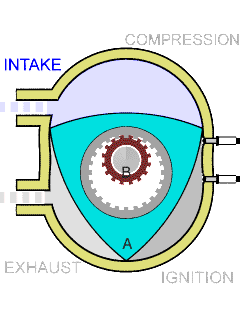Rotary engine

Rotary engines or Wankel engines are a type of internal combustion engine, most popularly used in the Mazda RX-7, which converts heat from the combustion of a high pressure air/fuel mixture into useful work for the rest of the car. Its unique characteristic is its triangular rotor, which performs the same tasks as a reciprocating engine's piston would, but in a very different manner.[2]
The rotor is contained in an oval shaped housing, and performs the common four-stroke cycle of an internal combustion engine, as seen in Figure 1. The rotor is connected to an output shaft which spins 3x faster than the rotor (inner circle labeled "B" in the Figure). This cycle is described below, and occurs 3 times for each spin of the rotor:[2]
- Intake: This initiates when the tip of the rotor passes the intake port. At this moment, the chamber is at its smallest and as it rotates the chamber expands—drawing in the air/fuel mixture. As soon as the rotor end passes the intake port, it moves on to the compression stage, while the next face of the rotor starts this step over.
- Compression: As the rotor continues spinning, the air/fuel mixture becomes compressed because the chamber is decreasing in size. This is necessary for the next part, which ignites this mixture.
- Ignition: The compressed mixture gets ignited by spark plugs, and the vast increase in pressure forces the rotor to expand. This is the power-stroke, providing useful work. Two spark plugs are often needed to provide even ignition throughout the chamber. The exhaust gas expands into the chamber, until the rotor tip passes the exhaust port.
- Exhaust: Once the tip passes this port, the high pressure exhaust gases can flow through the exhaust port. The rotor continues to spin until the end of its face passes the exhaust port, the tip passes the intake port, and the cycle repeats.
The interesting part of this cycle is that every step is occurring at the same time, just in different chambers. This gives three power-strokes for every turn of the rotor.
Differences from a Reciprocating Engine
Besides the different method to complete the four-stroke cycle, rotary engines have different advantages and drawbacks from the more common reciprocating engines:[2]
- Fewer moving parts: A two-rotor rotary engine has three moving parts—two rotors and an output shaft—while ordinary reciprocating engines have at least 40. This gives rotary engines better reliability.
- Smoother: The rotor spins constantly in one direction, unlike reciprocating engines whose pistons change direction abruptly. They are also counter-balanced by weights which reduce internal vibrations. The power delivery is also more continuous because of the three-power strokes for every turn of the rotor.
- Slower: The rotor spins at one-third the speed of the output shaft, so the main moving parts move slower than those in a piston engine. This improves reliability.
Drawbacks
Manufacturing costs can be higher due to the lower popularity of these engines. They also typically consume more fuel than other engines due to their low compression ratio and therefore have a lower thermal efficiency which makes it difficult for them to meet emission regulations.
For Further Reading
References
- ↑ Wikimedia Commons [Online], Available: http://upload.wikimedia.org/wikipedia/commons/f/fc/Wankel_Cycle_anim_en.gif
- ↑ 2.0 2.1 2.2 How Stuff Works, How Rotary Engines Work [Online], Available: http://auto.howstuffworks.com/rotary-engine1.htm

